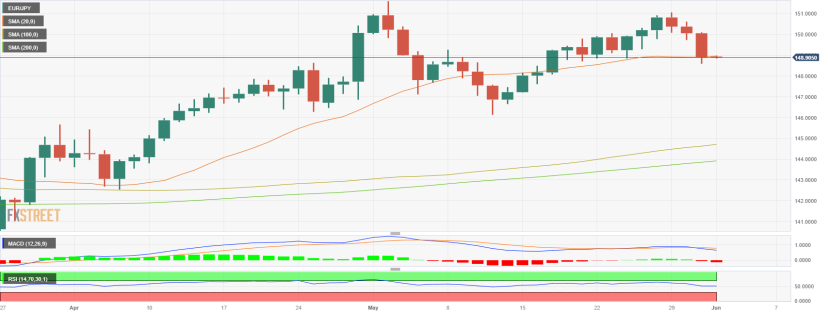
- The EUR/JPY fell to the 148.88 area to test the 20-day SMA
- Weak inflation figures from European countries weigh on the Euro amid falling German yields
- Yen’s gains remain capped by lower Japanese yields
The EUR/JPY fell to its lowest level since May 17 as weak inflation figures released by Germany and Spain from May made the Euro bulls lose interest in Wednesday's session. On the other hand, the latest Japanese economic data released in the early Asian session came in weak, limiting the Yen’s upside potential.
German yields decline amid weak Japanese economic data
The May data for the German Harmonized Index of Consumer Prices (HICP) indicated a deceleration to 6.3% year-on-year (YoY), down from the previous reading of 7.6% and below the consensus forecast of 6.8%. Similarly, Spain reported a decrease in its HICP to 2.9%, lower than the expected 3.4%. In that sense, the shorter-term German bond yields declined with the 2- and 10-year bond rates, seeing more than a 2% decrease while the 5-year yield managed to increase slightly . On the other hand, Japanese rates decreased, with the 5-year yield seeing a 12% decline on the day, and applied further pressure on the Yen.
Anticipated data for Thursday indicates a potential decline in the EU's HICP and a contraction in German retail sales, signaling a weakening economy. If inflation continues to decrease, there is a possibility that the ECB might adopt a less strict monetary policy stance, which could negatively impact on the Euro.
On the other hand, Japan reported that Industrial Production unexpectedly contracted in the month of April while Retail Sales from the same month also failed to live up to the market expectations, contracting 1.2% vs the consensus which expected a stagnation. The Large Retailer Sales was the only economic report which surpassed expectations, coming in at 4.8% MoM, in April vs the 3.8% expected.
Levels to watch
According to the daily chart, the EUR/JPY holds a bearish outlook for the short term as the Relative Strength Index (RSI) and Moving Average Convergence Divergence (MACD) suggest that the sellers are in control while the pair trades below its main moving averages.
The 20-day Simple Moving Average (SMA) at 148.80 level remains the key support level for EUR/JPY. If broken, the 148.50 area and 148.00 zone could come into play. Alternatively, a move above the 149.30 zone would suggest a boost for the pair’s upside momentum, with next resistances at the 149.50 area and 149.80 level.
